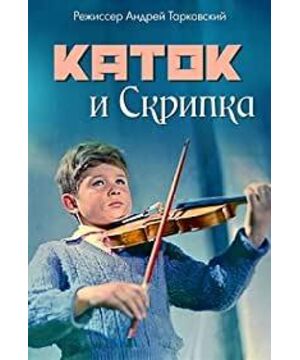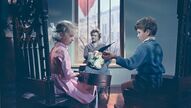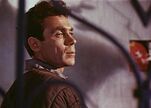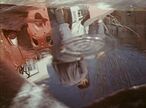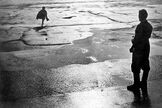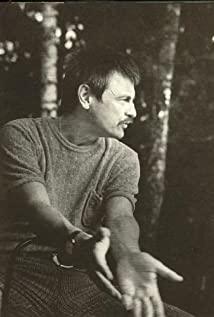Suddenly I found that the name of the first article of the hot review was repeated, but this was my first flash after watching this short film: "Children and Class", two abstract and appropriate opposite concepts-just like the Wilderness Hunter "Survival and Revenge" in the middle of the game shines with the vivid long lens and the Oscar-level acting of Xiao Lizi-this profound theme is also sharp and angular under the lens of Tarkovsky's textbook.
To be more abstract, the collision between a soul representing truth, goodness and beauty and an unreasonable system in society gave rise to these more than forty minutes of classics. From the very beginning, Sasha avoided the children who represent the proletariat. The good show has begun, just like the big vision of the opening of a general movie to explain the story and the environmental background. This is the epitome of the social environment, and it has been elicited. Pave the way for the utopian hand-offs of road rollers.
But the beginning of this vision expression was a performance that was almost pantomime with a little girl. A child is a typical representative of innocence and ideals, but due to class reasons, the cute little girl looks so shy when Sasha secretly gives the Qiubo, but her eyes are full of envy and desire, so the close-up shots of the apple core afterwards also look very Fresh and lovely. The heart of a child is classless.
Then came the highlight, the road roller "formally" met with Sasha for the first time after "rescuing" Sasha. This is also the first time that the film depicts a beautiful vision of breaking the class. Time is beautiful and timeless under the director's lens. Watching the demolition, playing the violin, and chatting together, everything looks beautiful. The lens and light and shadow effects used by the director during the period are very appropriate, which will be discussed later. However, there are some contradictions and unnaturalness behind the beauty. First of all, although the image of the road roller is also very beautiful, it is not completely overwhelming in the relationship between the two, even listening to music and listening to Sasha. The melancholy silence while speaking cast the pain of life on the screen again. Of course, there are two more prominent contradictions, and I think they highlight the good and bad of the two classes respectively. The first place appeared at the corner. The two saw a child bullying another child. Sasha’s first reaction was to get justice. Instead, the road roller relentlessly walked away after saying "this is not fair". After all, there is only He knew that bullying and class had gone deep into his bones, and futile resistance was useless. The second appeared when Sasha was so angry that he threw bread to the ground after the road roller laughed that he was a musician (the ridicule of other children before him), and was criticized because he didn't know that bread is for the people at the bottom. What it means is an obvious social epitome. But this can't stop their friendship, they have an appointment with a movie.
However, contradictions always exist. The typical aristocratic thought of Sasha’s mother has turned everything into a bubble, a typical tragic ending. But the girl who pursued the road roller also plucked up the courage to ask him to watch a movie, which seemed to be a trivial but inspiring hope of the proletariat. The paper airplane with the reason written on it flies with the wind, and only carries one person's worries. It falls on the ground. What if there are class differences, but no one pays attention to the paper airplane. Life continues like this. In the end, the beautiful vision that Sasha had imagined was just a vision, as the roller drifted away diagonally.
Of course, the highlight of this small film is not only in the plot, but also in the textbook. There are several shots that impressed me the most. 1. Sasha looks at the colorful world of prism-like glaze outside the window. Every scene is magnificent and fresh in the kaleidoscope-like composition. The children's innocent understanding and observation of the outside world are vividly displayed on the screen. 2. When Sasha finished the test and left in frustration, the lens focused on the apple core, and the lens with Sasha's blurred back as the background conveyed a lot of information. The lens from top to bottom has a childlike and cute feeling. The drama of the two children ends here, but the audience only knows the subtleties of their relationship. 3. The sculpting of light and shadow, for example, when two people are together, the lens is reflected in the water many times, and water droplets break up the entire picture from time to time, which symbolizes that the relationship between the two is destined to be a bubble. It is so uncertain and does not suit people. The pictures of normal visual habits are full of strong uncertainty. In addition, the light reflected by the sun also hit their faces many times, which may be a way to express their mood. 4. The use of the mirror, the image of the mother and the imagination of oneself looking at the mirror at the end all use the reflection of the mirror to unfold the main plot.
Don't look at this short 40-minute film, but the sparrow is small and well-equipped, with extremely refined shots, and the editing makes almost every shot has its own meaning. In addition, I don’t know much about the history of Russia, and there are many places I don’t understand. For example, I spent a lot of time watching the demolition process together, but I can’t understand why I wanted to shoot this section, why the weather suddenly changed to rain, and why? Afterwards, why would there be a wall that was demolished and a building reflecting the golden sunlight leaked out? What kind of beauty does it symbolize? There are many details such as the many details and composition in the dialogue between the two, and a few overlooking perspectives (meeting after raining and clearing, the embarrassing scene when throwing bread, and the final beautiful vision), why should we arrange this and a series of questions. . Nevertheless, or because of this, I like this film so much. The language of the lens is beautiful and appropriate, just like reading a good book with beautiful language, which makes people very comfortable.
A movie falls in love with Tarkovsky, and likes to bathe in the time he sculpts.
View more about The Steamroller and the Violin reviews


